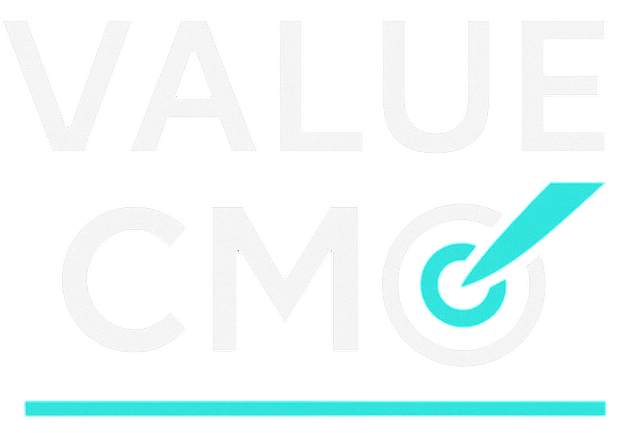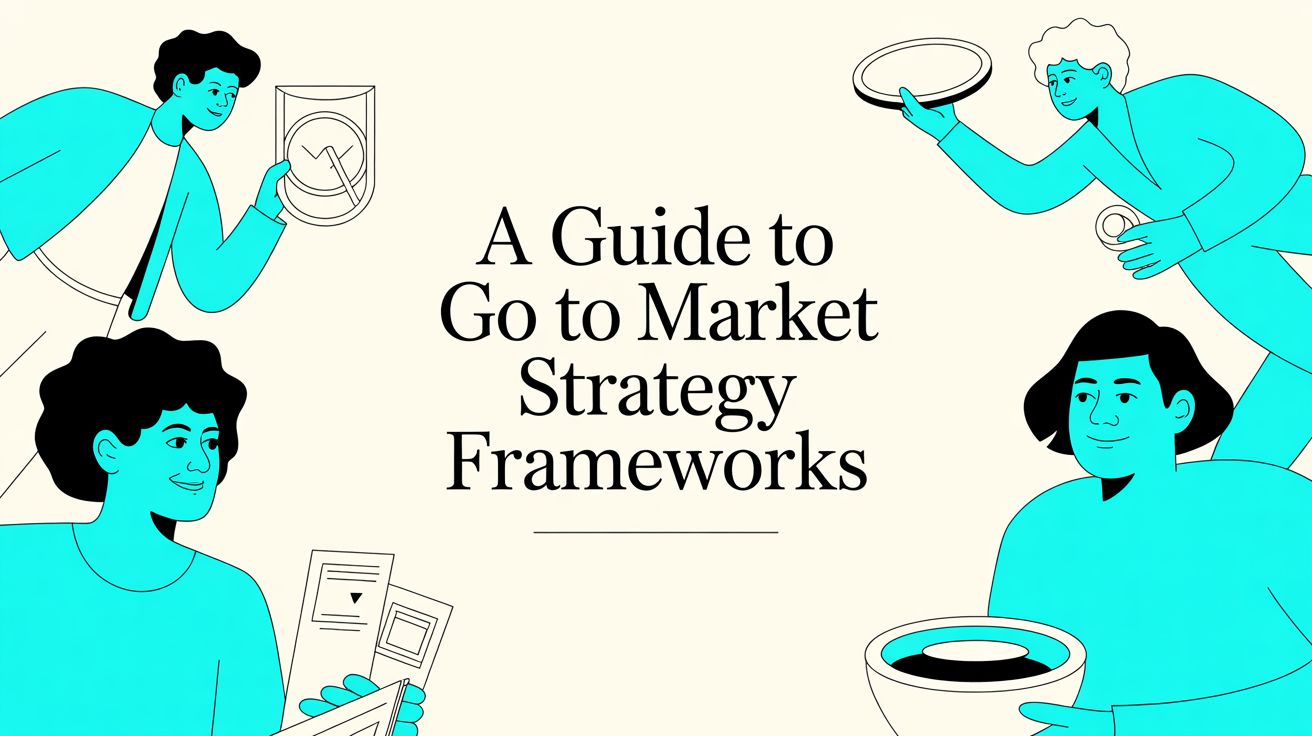Ever seen a promising product with massive potential just… fizzle out? The difference between a rocket ship launch and one that never leaves the ground is rarely luck. It’s a solid plan.
A go-to-market (GTM) strategy framework is that mission plan. It’s not just another business document; it’s the shared roadmap that gets your marketing, sales, and product teams all flying in the same direction. It’s what turns a great idea into a market-leading product by giving everyone clarity and a clear destination.
The Blueprint for a Successful Launch
Trying to launch a product without a GTM framework is like building a house without a blueprint. You might have the best materials and a skilled crew, but you’ll end up with crooked walls, wasted money, and a structure that can’t stand up under pressure.
Your GTM framework is your architectural plan for market success. It makes you answer the tough questions upfront: Who are we actually selling to? What problem are we really solving for them? How will we reach them, and what will we say to get their attention? Nailing down these answers brings a laser focus to your team and your budget.
This visual breaks down the core benefits in a nutshell.
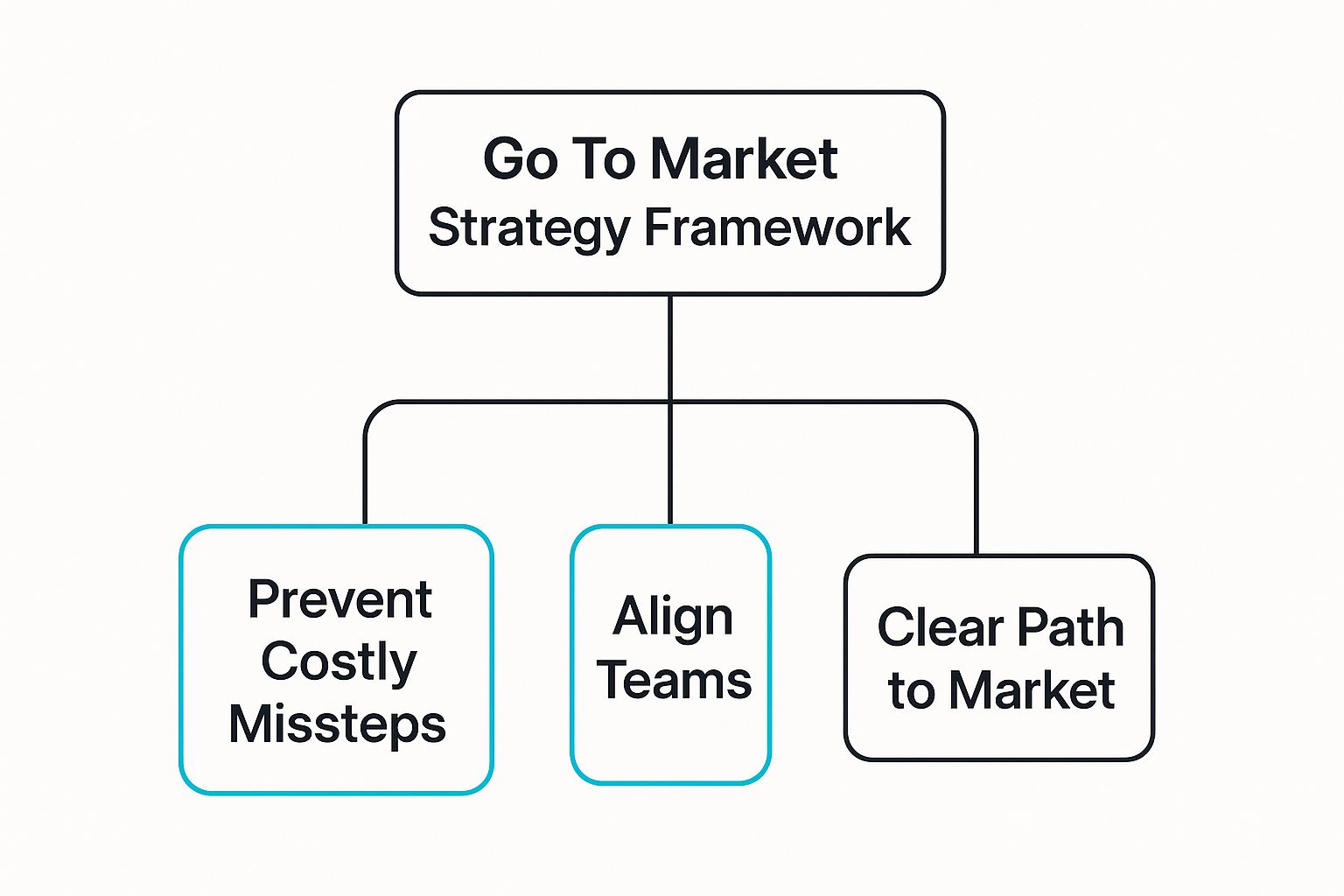
As you can see, the framework is the central hub that prevents expensive mistakes, aligns your teams, and carves out a direct path into the market.
Aligning Your Teams for Maximum Impact
One of the biggest jobs of a GTM framework is forcing everyone to get on the same page. When marketing, sales, and product teams are stuck in their own silos, you get mixed messages, a clunky customer experience, and a ton of missed opportunities.
A well-defined GTM strategy ensures every team understands their role, speaks the same language, and works from the same playbook. This unified approach is your key to making a genuine impact.
Despite how critical this is, a surprising number of companies are still flying blind. Recent data shows that 15.4% of companies still don’t have a defined GTM strategy, which points to a huge gap in formal launch planning. You can dig into more industry stats to see the state of GTM planning.
That lack of preparation is a major handicap in a competitive market. By creating a clear path forward, you empower every person on your team to contribute effectively. It turns your launch from a game of chance into a calculated, coordinated mission.
The Four Core Pillars of Your GTM Framework
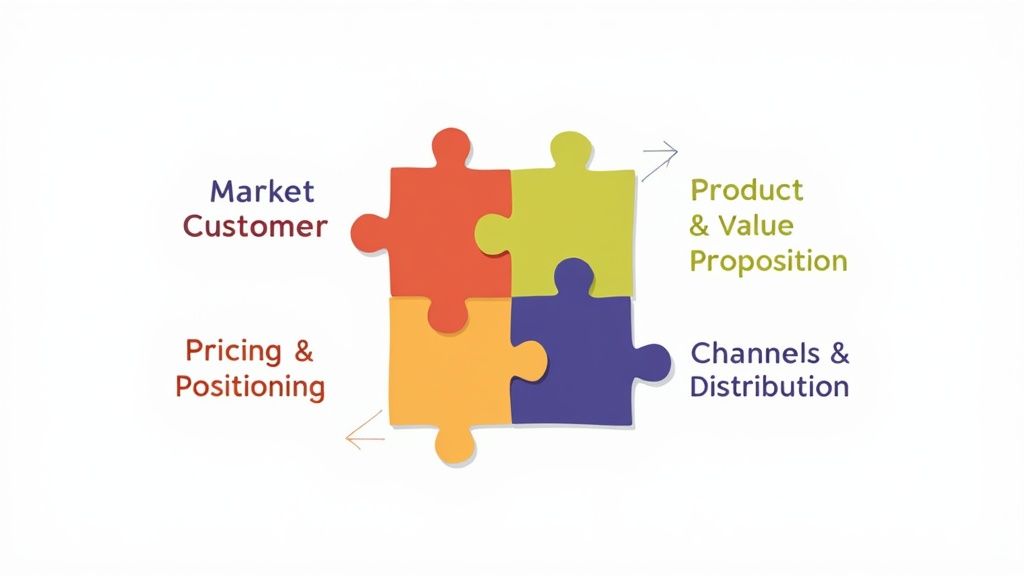
A solid go-to-market strategy isn’t some bloated checklist of marketing tasks. It’s a lean framework built on four pillars that have to work together. Think of them like the four load-bearing walls of a house—if one is shaky, the whole structure is at risk of collapse.
But when you get them right, they create a solid foundation for your launch and, more importantly, for long-term growth. Let’s break down what they are and how they lock into place.
Pillar 1: Market and Customer Focus
Before you can sell a single thing, you have to know exactly who you’re selling to. This pillar is about getting obsessed with your customer—moving past vague demographics to genuinely understand the people whose problems you solve. It all starts with defining your Ideal Customer Profile (ICP) with laser-like clarity.
What problems keep them up at night? What are their biggest frustrations at work? Where do they hang out online to find information? Answering these questions gives you a compass for every other decision. A B2B software company might realize their true ICP isn’t the CEO, but a mid-level manager drowning in inefficient manual workflows.
This deep insight stops you from shouting into the void. Instead, you’re having a direct conversation with the right people about the specific issues they actually care about.
Pillar 2: Product and Value Proposition
Once you have a crystal-clear picture of your customer, you can nail down the “what.” This pillar is all about your product or service and, critically, the unique value it delivers. This is not the place for a laundry list of features; it’s where you articulate the solution to your customer’s pain. This is your value proposition.
A powerful value proposition answers one simple question from the customer’s point of view: “What’s in it for me?”
Your value proposition is the promise you make to your customer. It’s the dead-simple explanation of how you solve their problem or make their life better, and what makes you the only real choice.
To get this right, you have to connect your product’s capabilities directly to the problems you uncovered in Pillar 1. If that mid-level manager is your ICP, your value prop isn’t “We sell workflow automation software.” It’s “We give you back 10 hours a week by killing manual data entry, so you can actually lead your team.” See the difference? One is a feature; the other is a bottom-line benefit.
Pillar 3: Pricing and Positioning
How you price your product sends a strong signal about its value and who it’s for. This is where you define your product’s spot in the market. Positioning is about crafting the story around your product, while pricing is the tangible proof of that story.
Are you the premium, white-glove solution or the affordable, self-service option? Your pricing model—whether it’s a subscription, a one-time fee, or usage-based—has to match both your customer’s budget and your business goals. It’s not uncommon for a startup to find their initial pricing creates too much friction. For instance, a high upfront cost might be a deal-breaker for small businesses, while a simple monthly subscription feels totally manageable.
This pillar forces you to look at competitors, but not to copy them. The goal is to understand their positioning so you can carve out your own unique space and become the obvious choice for your ICP. For B2B companies, a well-defined plan is non-negotiable; you can dive deeper into what makes a winning B2B marketing strategy here.
Pillar 4: Channels and Distribution
Finally, how are you actually going to get your product in front of your customers? This pillar covers the paths you’ll use to market and sell your solution. These are your distribution channels, and they absolutely must be where your ideal customers already spend their time.
You’ve got a whole menu of options to consider:
- Direct Sales: Building an in-house sales team to forge direct relationships.
- Content Marketing: Creating valuable guides, articles, and videos that pull customers in organically.
- Paid Advertising: Using platforms like Google Ads or LinkedIn to reach a targeted audience on demand.
- Partnerships: Teaming up with other companies who serve the same audience without being direct competitors.
Choosing the right channels always comes back to Pillar 1. If your ICP lives in professional groups on LinkedIn, then a strategy combining direct outreach and paid social on that platform makes a ton of sense. If they rely on industry blogs for research, content marketing is your best bet. Trying to be everywhere at once is a classic recipe for a drained budget and zero traction.
The Four Pillars of Your Go To Market Strategy
To bring it all together, these four pillars aren’t independent tasks but interconnected components of a single, cohesive strategy. Each one informs the others, creating a powerful feedback loop that drives your market entry and growth.
| Pillar | Key Question It Answers | Core Business Function |
|---|---|---|
| Market & Customer | Who are we selling to, and what problem do they have? | Defines the target audience and their core needs. |
| Product & Value Prop | What are we selling, and why is it the best solution? | Articulates the unique benefit and competitive edge. |
| Pricing & Positioning | How much does it cost, and where does it fit in the market? | Establishes perceived value and market narrative. |
| Channels & Distribution | Where and how will customers find and buy our product? | Outlines the path from the business to the customer. |
When these four gears are turning in sync, you have a GTM machine built to win. If one is out of alignment, the whole system grinds to a halt.
How to Build Your Go To Market Strategy Step by Step

Okay, let’s move from theory to action. This is where your go-to-market strategy stops being a concept and starts becoming a real, working plan. Forget filling out a generic template; this is about making a series of smart, connected decisions that build on each other.
Think of it like assembling a high-performance engine. Each component has to fit perfectly with the next. Get it right, and you create a powerful system that moves you from a product idea to real market traction—fast.
Here’s how to build that engine, piece by piece.
Step 1: Start with Your Ideal Customer Profile
Everything starts and ends with the customer. Before you write a single line of ad copy or choose a sales channel, you have to know exactly who you’re building for. That means getting laser-focused on your Ideal Customer Profile (ICP).
And I don’t mean a vague demographic like “mid-sized tech companies.” A strong ICP is painfully specific. It details company size, industry, geography, and the exact challenges the people inside those companies face. The goal is a portrait so clear your whole team could spot your perfect customer in a crowd.
Your ICP is the bullseye on the dartboard. Without it, you’re just throwing darts in a dark room and hoping one sticks. A sharp ICP ensures every ounce of effort and budget is aimed right where it needs to be.
Once you know the company, you need to zoom in on the people. That means developing buyer personas for the key players involved. According to Gartner, a typical B2B purchase involves six to ten decision-makers. You need a plan for each of them.
- The Initiator: The person who first flags the problem.
- The User: The team member who will live in your product every day.
- The Influencer: The trusted advisor whose opinion carries weight.
- The Decision-Maker: The exec who gives the final yes or no.
- The Buyer: The one who controls the purse strings.
Understanding their individual motivations, pain points, and what a “win” looks like for them is how you craft messages that actually get a response.
Step 2: Map the Complete Customer Journey
Now that you know who they are, you need to map how they buy. The customer journey reveals the path people take from the first flicker of a problem to becoming a loyal fan of your solution.
This journey is almost never a straight line. It’s a winding road with stops and starts across different channels. Your job is to understand each stage and meet them there with the right information.
- Awareness Stage: The customer knows they have a problem but isn’t sure what to do about it. Your goal is education, not a hard sell. Think blog posts, webinars, and original research that help them name their pain.
- Consideration Stage: They’re now actively researching options. This is where you serve up case studies, product comparisons, and detailed guides that position your solution as the clear choice.
- Decision Stage: The customer is ready to pull the trigger. Make it easy for them. Offer free trials, live demos, clear pricing, and powerful testimonials.
Mapping this process shows you exactly where you need to be and what you need to say at every critical moment. For B2B companies, a detailed journey map is a non-negotiable part of any solid B2B marketing plan.
Step 3: Craft and Test Your Value Matrix
With a solid grasp of your personas and their journey, it’s time to build a value matrix. This is a simple but powerful tool that connects each persona’s specific pain points to your product’s features—and translates that into a message that hits home.
For each persona you identified, create a simple chart like this:
| Persona | Core Pain Points | Your Solution’s Value | Key Message |
|---|---|---|---|
| Marketing Manager | Wasting hours on manual reporting | Automates report generation, saving 10 hours/week | “Stop building reports. Start analyzing results.” |
| Sales Director | Inaccurate sales forecasting | Provides real-time pipeline data for better accuracy | “Get a sales forecast you can finally trust.” |
This simple exercise forces you to stop listing features and start talking about tangible business outcomes. But don’t just assume your messages will work. Test them. Run small, targeted ad campaigns on LinkedIn to see which messages get the most engagement. This lets data, not guesswork, refine your messaging before you put real money behind it.
Step 4: Define Your Sales and Marketing Channels
The final step is deciding how you’ll reach your customers and guide them through their journey. This means picking the right mix of channels based on where your ICP actually spends their time.
There are four main sales strategies to consider:
- Self-Service: Customers find and buy your product on their own with little to no human help. This works great for low-cost, high-volume products.
- Inside Sales: A remote sales team nurtures and closes leads over phone, email, and video. It’s a good fit for products with medium complexity and price points.
- Field Sales: A dedicated sales team meets with enterprise clients face-to-face to close large, complex deals. This is a high-cost model reserved for high-value contracts.
- Channel Sales: You partner with third-party agencies, resellers, or affiliates who sell your product for you. This can scale your reach quickly but offers less control.
Your marketing channels should feed your chosen sales model. If you have an inside sales team targeting marketing managers, a focused content strategy with SEO-driven articles and targeted LinkedIn ads is a killer combo for generating inbound leads. The key is to dominate a few channels where your customers live instead of spreading yourself thin trying to be everywhere at once.
Learning from Real World GTM Strategy Examples
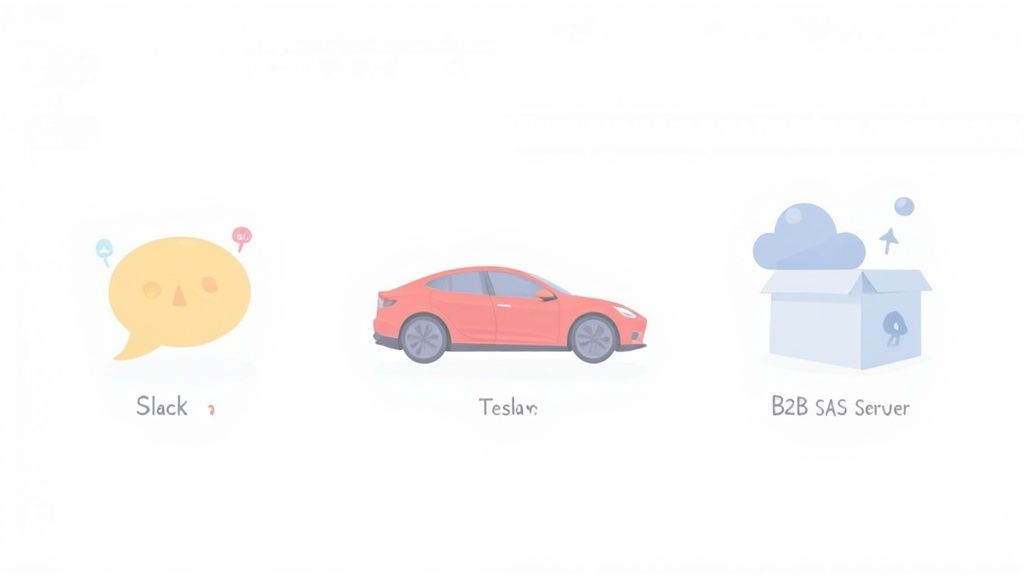
Theory is one thing, but seeing a go-to-market strategy framework in action is where the real learning kicks in. The most successful companies didn’t just trip over their target audience; they launched highly specific, often unconventional, plans.
Let’s dissect the playbooks of a few game-changers. By breaking down their strategies into our four core pillars—market, product, pricing, and channels—we can see how they built their empires and find some inspiration for our own.
Slack: The Bottom-Up Revolution
Slack didn’t start by pitching CIOs. Their whole game was to build a product that individual teams would absolutely love, creating a groundswell from within that executives simply couldn’t ignore.
Their approach was a masterclass in a bottom-up GTM strategy.
- Target Market: They didn’t aim for entire companies. Instead, they laser-focused on small, tech-savvy teams inside larger organizations—engineers, designers, and product managers drowning in email. They targeted the users, not the buyers.
- Product-Market Fit: Slack completely nailed the user experience. They knew their real competition wasn’t another chat app; it was the chaotic mess of email chains, clunky file-sharing services, and stale internal wikis. The product was a single, elegant solution to a very messy problem.
- Pricing: The freemium model was the rocket fuel for their growth. A generous free tier let any team get started without a credit card or a single budget meeting. This eliminated all the usual friction, turning early adopters into internal evangelists who eventually made the business case for paid plans.
- Distribution: Word-of-mouth was their main channel, supercharged by the freemium product itself. When one team started using Slack, other teams saw it, creating a viral loop inside the company. This is product-led growth in its purest form—the product did the selling.
Tesla: The Direct-to-Consumer Disruption
Tesla didn’t just enter the century-old automotive industry; they rewrote the rulebook. While every other carmaker leaned on a massive web of third-party dealerships, Tesla went straight to the consumer, controlling the entire experience from the first click to the final handover.
This direct model was the beating heart of their go-to-market strategy.
- Target Market: Tesla started at the top. They targeted wealthy, tech-forward early adopters with the Roadster, which built incredible brand cachet and generated the cash needed to eventually build more affordable cars for the rest of us.
- Product-Market Fit: They weren’t just selling an electric car; they were selling a high-performance piece of technology that happened to have wheels. With a focus on software, over-the-air updates, and a minimalist design, the product felt more like a premium gadget than a traditional vehicle. Nailing this took intense focus, and you can learn more about how modern companies tackle this by exploring product-market fit in the AI era.
- Pricing: Tesla’s pricing was transparent and non-negotiable. By cutting out the dealership, they killed the painful haggling process most people hate, creating a simple, premium buying experience that reinforced the brand’s value.
- Distribution: Their channels were entirely their own. You order online or visit a sleek, Apple-style showroom in a high-end mall. This gave Tesla total control over their story and a direct line to every customer.
By owning the entire GTM process, from manufacturing to the final sale, Tesla built an incredibly powerful brand and a direct line to its customers, a feat legacy automakers still struggle to replicate.
The Scrappy B2B SaaS Niche Dominator
Now, let’s look at a less famous but equally smart example: a bootstrapped B2B SaaS startup targeting a tiny niche, like compliance software for regional banks. They can’t rely on a nine-figure marketing budget or a household name.
They win by being hyper-focused and ruthlessly efficient.
- Target Market: They don’t even look at the big enterprise banks. Their entire world is regional banks with 50-200 employees. Their Ideal Customer Profile is the Chief Compliance Officer, a persona they know inside and out from dozens of one-on-one interviews.
- Product-Market Fit: Their product isn’t bloated with features. It solves one specific, painful problem for their ICP—automating a single regulatory report that’s tedious, time-consuming, and prone to costly errors. It does one job perfectly.
- Pricing: No complex tiers or usage-based models here. They offer a simple, flat-rate annual subscription. This predictability is a huge plus for the careful budget cycles of their target banks, making it an easy “yes.”
- Distribution: Their channels are lean and direct. They use targeted LinkedIn outreach to connect with CCOs, sponsor one niche industry newsletter, and present at the one annual conference that really matters. Every dollar is spent talking directly to their ideal buyer.
How to Measure and Optimize Your GTM Plan
Getting your product out the door isn’t the finish line—it’s the starting gun. A go-to-market plan isn’t something you carve in stone and admire from a distance. It’s a living document that has to bend and adapt to what the market tells you. Without measurement, you’re just guessing.
This is where you shift from architect to operator. The real work is creating a tight feedback loop: launch something, measure what happens, learn from the data, and then tweak your approach. This cycle of continuous improvement is what turns a decent launch into a durable business.
Focusing on Metrics That Matter
It’s incredibly easy to get lost in a sea of data. Clicks, impressions, and website visits—what we call vanity metrics—can feel good, but they don’t actually pay the bills. To get a real read on your GTM plan’s health, you have to track the numbers directly tied to revenue and growth.
These are the metrics that tell you if your strategy is actually working from a business standpoint.
- Customer Acquisition Cost (CAC): This is your total sales and marketing spend divided by the number of new customers you brought in. Simply put, it’s the price you pay to win one new customer.
- Customer Lifetime Value (LTV): This metric forecasts the total revenue you can expect from a single customer over the entire time they do business with you.
- LTV to CAC Ratio: This is the magic number. A healthy, sustainable business model typically needs an LTV that’s at least 3x its CAC. If your ratio is 1:1, you’re literally losing money with every new customer you sign.
- Sales Cycle Length: How long does it take to turn a lead into a paying customer? Tracking this helps you forecast revenue more accurately and spot the bottlenecks slowing down your deals.
- Conversion Rates: This isn’t a single number; it’s a series of them. You need to know the conversion rate at each stage of your pipeline. What percentage of demo requests become qualified opportunities? How many of those ops close?
These numbers tell a story about the efficiency and profitability of your entire go-to-market motion. They move you beyond surface-level activity and into deep business impact.
Building Your GTM Dashboard
You don’t need a complicated, six-figure business intelligence tool to get started. A simple dashboard, even one built in a spreadsheet, can give you the clarity needed to make sharp decisions. The key is to keep it ruthlessly focused on the core metrics we just covered.
Think of your dashboard as mission control. It should give you a clean, at-a-glance view of how you’re tracking against the goals you set in your plan.
Your GTM dashboard isn’t just for tracking progress; it’s a decision-making tool. It should immediately tell you what’s working, what’s broken, and where your best opportunities for growth are hiding.
For instance, your dashboard might show that one marketing channel has a dramatically lower CAC than all the others. That’s not just data; it’s a clear signal from the market telling you exactly where to double down with your time and budget.
Knowing When to Pivot or Persevere
With your key metrics in hand, you can finally make data-informed adjustments instead of emotional ones. The data will tell you when it’s time to pivot your strategy or when you just need to persevere and give a tactic more time to mature.
Here’s how to read what the numbers are telling you:
- Double Down on Winners: If a specific channel, message, or customer segment is delivering a fantastic LTV to CAC ratio, it’s time to pour fuel on the fire. This is how you scale efficiently.
- Optimize the Underperformers: Maybe your CAC is too high on a particular channel. Before you kill it, can you fix it? Could better ad copy, a tighter audience, or a different landing page improve the conversion rate and bring down the cost?
- Cut the Losers: If you’ve tried to optimize a channel and the numbers still don’t add up, be ruthless. Every dollar you spend on a failing tactic is a dollar you can’t invest in a winning one.
- Refine Your ICP: Is your sales cycle dragging on forever? Are conversion rates abysmal? It might be a sign you’re talking to the wrong people. Use feedback from your sales team and your customer data to sharpen your Ideal Customer Profile.
This continuous process of measuring and optimizing transforms your go-to-market plan from a static document into a dynamic engine for sustainable growth. It ensures your business stays aligned with the realities of the market, not just the assumptions you started with.
Common Questions About GTM Frameworks
Even the best roadmaps have a few confusing turns. When you’re deep in the weeds of building a go-to-market framework, questions are going to pop up. It’s a complex process with a lot of moving parts.
Let’s tackle some of the most common ones I hear from founders and marketing leaders. Getting these straight will help you sidestep common mistakes and move forward with more confidence.
How Is a GTM Strategy Different from a Business Plan?
It’s easy to get these two mixed up, but they play very different roles.
Think of your business plan as the entire atlas for your company. It lays out the high-level vision, financial projections, operational structure, and your biggest corporate goals. It’s the A-to-Z document covering the whole organization.
A go-to-market strategy, on the other hand, is one specific, detailed map from that atlas. It’s the turn-by-turn GPS route for launching a single product or entering a new market. It’s a focused, actionable chapter within that bigger business plan, dedicated to one mission: successfully connecting a specific product with its ideal customers.
How Often Should I Update My GTM Framework?
A go-to-market strategy should never be a “set it and forget it” document. If it’s gathering dust on a server, it’s already useless. The market is always moving, and your plan needs to be a living, breathing guide that adapts right along with it.
Treat your GTM framework as a dynamic tool, not a static artifact. Regular reviews are what keep it relevant and effective in a changing market.
As a rule of thumb, do a quick check-in on your core metrics every quarter to make small course corrections. But plan for a much deeper overhaul at least once a year, or whenever a major event shakes things up. These triggers could be:
- You get a wave of new customer feedback or market data.
- A major competitor makes a big move—either entering or leaving your space.
- You pivot your product’s core features or value proposition.
Can a Startup with a Small Budget Still Create an Effective GTM Strategy?
Absolutely. In fact, for a startup, a solid GTM strategy is non-negotiable. When you’re running lean, you can’t afford to waste a single dollar or hour on tactics that don’t move the needle. A sharp GTM framework is your best friend.
It forces you to make tough, smart choices about where to place your bets. Instead of trying to be everywhere at once, your strategy pinpoints the most direct and effective channels to reach your ideal customers. It ensures your small budget is concentrated where it will have the biggest impact, helping you maximize your return from day one.
What Is the Single Biggest Mistake Companies Make?
By far, the most common and costly mistake is building a GTM strategy from the inside-out. Too many companies fall in love with their own product and build a plan based on internal assumptions about what they think customers want. They get obsessed with features, not with solving real-world pain points.
A winning GTM is always built from the outside-in. It starts with a deep, almost obsessive understanding of the customer—their problems, their workflows, and what they truly value. Every single decision, from your messaging to your pricing, has to flow from that customer-centric foundation.
At Value CMO, we build these customer-centric go-to-market strategies that get B2B tech companies to their next stage of growth. If you need an expert hand to define your ideal customer, align your teams, and build a revenue engine that delivers, we should talk. Learn more about our approach.
